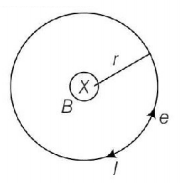Question
An electron moving in a circular orbit of radius $$r$$ makes $$n$$ rotations per second. The magnetic field produced at the centre has magnitude
A.
$$\frac{{{\mu _0}ne}}{{2\pi r}}$$
B.
zero
C.
$$\frac{{{\mu _0}{n^2}e}}{r}$$
D.
$$\frac{{{\mu _0}ne}}{{2r}}$$
Answer :
$$\frac{{{\mu _0}ne}}{{2r}}$$
Solution :
As, $$I = \frac{q}{t}.$$ So, for an electron revolving in a circular orbit of radius $$r$$

$$q = e\,\,{\text{and}}\,\,t = T$$
$$ \Rightarrow I = \frac{e}{T} = \frac{e}{{\frac{{2\pi }}{\omega }}} = \frac{{\omega e}}{{2\pi }} = \frac{{2\pi ne}}{{2\pi }} = ne$$
The magnetic field produced at the centre is
$$B = \frac{{{\mu _0}I}}{{2R}} = \frac{{{\mu _0}ne}}{{2r}}$$
As, $$I = \frac{q}{t}.$$ So, for an electron revolving in a circular orbit of radius $$r$$

$$q = e\,\,{\text{and}}\,\,t = T$$
$$ \Rightarrow I = \frac{e}{T} = \frac{e}{{\frac{{2\pi }}{\omega }}} = \frac{{\omega e}}{{2\pi }} = \frac{{2\pi ne}}{{2\pi }} = ne$$
The magnetic field produced at the centre is
$$B = \frac{{{\mu _0}I}}{{2R}} = \frac{{{\mu _0}ne}}{{2r}}$$